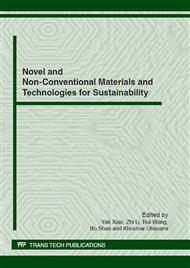p.536
p.547
p.556
p.564
p.570
p.577
p.583
p.589
p.595
Availability of Resilient Modulus and Permanent Deformation Laboratory Tests of Stabilized Soil with Coal Ashes for Pavements Base
Abstract:
Fly and Bottom ash a coal combustion residue of thermal power plants has been regarded as a problematic residue all over the world. This study presents the results of testing for resilient modulus and permanent deformation to evaluate the mechanical properties of a soil stabilized with fly or bottom ashes, with and without lime addition. The soil tested is a regional sandy soil, which is not suitable for use in pavement works. The addition of fly ash with lime improved their mechanical properties, these being dependent on the ash content, moisture and number of load cycles. However in the mixtures only with ashes, the improvement was lower than the mixtures with ashes and lime. It was performed a paving project to assess their competitiveness as a base material for pavements. The results of this project showed that the soil stabilized with ashes is competitive for low volume traffic roads, with the advantages of minimizing the environmental problems caused by coal ash disposal.
Info:
Periodical:
Pages:
570-576
Citation:
Online since:
June 2012
Authors:
Keywords:
Price:
Сopyright:
© 2012 Trans Tech Publications Ltd. All Rights Reserved
Share:
Citation:


